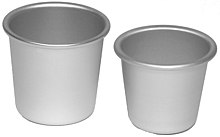Dariole is a French term for a small culinary mold in the shape of a truncated cone. The word also refers to the dessert that is baked in the mold. Classically, the dessert is an egg-custard filled puff pastry. In the Middle Ages they sometimes included fruit, cheese, bone marrow or fish inside the pastry.[citation needed]
 Two dariole molds | |
| Course | Dessert |
|---|---|
| Place of origin | France |
| Region or state | Provence |
| Main ingredients | Puff pastry, egg custard |
| Variations | Liquor-laced frangipane |
An early 20th century recipe replaced the traditional custard with liquor-laced frangipane. Today there are also savory darioles, usually made with vegetable custards.
History
editAccording to the fourteenth-century household book, Le Ménagier de Paris, which does not include a recipe for the dessert, darioles were served at weddings. Recipes from later English records and the 1486 edition of Le Viandier are unclear. A 15th century Italian recipe for a large custard tart called dariola is known. By the 18th-century, the dessert had taken the form of a small custard tart with fluted sides. In late 19th-century recipes, the custard is elaborately flavored and scented with citron, orange flower water, and vanilla sugar. The recipe from Larousse gastronomique filled the pastry with liquor-laced frangipane instead of custard.[1]
See also
editReferences
edit- ^ The Oxford Companion of Sugar and Sweets. Oxford University Press. April 2015. ISBN 978-0-19-931362-4.